Pump Handbook by Igor J. Karassik, Joseph P. Messina, Paul Cooper, Charles C. Heald - 3rd edition
Подождите немного. Документ загружается.

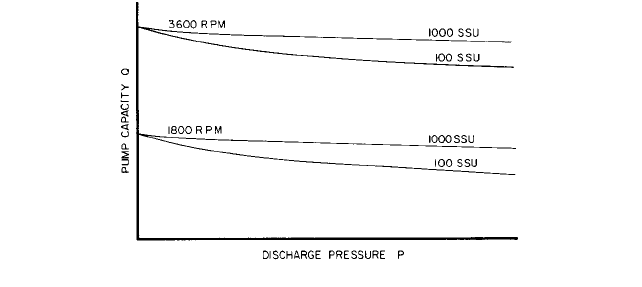
3.114 CHAPTER THREE
FIGURE 17 Head-capacity (flow rate) performance curve with viscosity a parameter—for two speeds.
liquids are accordingly known as true or Newtonian liquids, for which the viscosity is con-
stant. Another class of liquids, however, such as cellulose compounds, glues, greases,
paints, starches, slurries, and candy compounds, displays changes in viscosity as agita-
tion is varied at constant temperature. The viscosity of these substances depends upon
the shear rate at which it is measured, and these fluids are termed non-Newtonian.
If a substance is known to be non-Newtonian, the expected viscosity under the actual
pumping conditions should be determined, because it can vary quite widely from the vis-
cosity under static conditions. Since a non-Newtonian substance can have an unlimited
number of viscosity values (as the shear rate is varied), the term apparent viscosity is used
to describe its viscous properties.The apparent viscosity is expressed in absolute units and
is a measure of the resistance to the flow at a given shear rate. It has meaning only if the
shear rate used in the measurement is also given.
The grease-manufacturing industry is very familiar with the non-Newtonian proper-
ties of its products, as evidenced by the numerous curves that have been published of the
apparent viscosity plotted against the rate of shear. The occasion is rare, however, when
one can obtain accurate viscosity information when it is necessary to select a pump for
handling these products.
It is practically impossible in most instances to give the viscosity of grease in the terms
most familiar to the pump manufacturer, such as Saybolt Seconds Universal or Saybolt
Seconds Furol, but only a rough approximation would be of great help. For applications of
this type, data taken from similar installations are most helpful. Such information should
consist of the type, size, flow rate, and speed of the installed pumps; the suction pressure;
the temperature at the pump inlet flange; the total working suction head; and, above all,
the pressure drop in a specified length of piping. From the latter, a satisfactory approxi-
mation of the effective viscosity under the operating conditions can be obtained.
If accurate shear rate-viscosity data are available, they can be used to more accurately
predict pump performance.The shear rates in various areas of the pump can be calculated
to determine the viscosity changes of the liquid as it passes through the pump. In this way,
the effect on suction loss, slip, and friction loss can be analyzed to help predict the NPSH,
flow rate, and power.
Speed It was previously stated that viscosity and speed are closely tied together and
that it is impossible to consider one without the other. Although rotative speed is the ulti-
mate outcome, the basic speed that the manufacturer must consider is the internal axial
velocity of the liquid going through the rotors. This is a function of pump type, design,
and size.
Rotative speed should be reduced when handling liquids of high viscosity. The reasons
for this are not only the difficulty of filling the pumping elements, but also the mechani-
cal losses that result from the shearing action of the rotors on the substance handled. The

3.7 SCREW PUMPS 3.115
reduction of these losses is frequently of more importance than relatively high speeds,
even though the latter might be possible because of positive inlet conditions.
Capacity The delivered capacity (flow) of any screw pump, as stated earlier, is the the-
oretical capacity less the internal leakage, or the slip, when handling vapor-free liquids.
For a particular speed, Q Q
t
S, where the standard unit of Q and S is the U.S. gallon
per minute (cubic meter per minute).
The delivered capacity of any specific rotary pump is reduced by
• Decreasing speed
• Decreased viscosity
• Increased differential pressure
The actual speed must always be known. Most often, it differs somewhat from the
rated or nameplate specification. This is the first item to be checked and verified in ana-
lyzing any pump performance. It is surprising how often the speed is incorrectly assumed
and later found to be in error.
Because of the internal clearances between rotors and their housing, lower viscosities
and higher pressures increase the slip, which results in a reduced flow rate for a given
speed. The impact of these characteristics can vary widely for the various types of pumps.
The slip, however, is not measurably affected by changes in speed and thus becomes a
smaller percentage of the total flow at higher speeds.This is a significant factor in the han-
dling of low-viscosity fluids at higher pressures, particularly in the case of untimed screw
pumps that favor high speeds for the best results and best volumetric efficiency. This will
not generally be the case with pumps having support-bearing speed limits.
Pump volumetric efficiency E
v
is calculated as
with Q
t
varying directly with speed. As stated previously, the theoretical capacity of a
screw pump varies directly as the cube of the nominal diameter. Slip, however, varies
approximately with the square of the nominal diameter. Therefore, for a constant speed
and geometry, doubling the rotor size will result in an eightfold increase in theoretical flow
rate and only a fourfold increase in slip. It follows therefore that the volumetric efficiency
improves rapidly with increases in the rotor size.
On the other hand, viscosity changes affect the slip inversely to a certain power, which
has been determined empirically. An acceptable approximation for the range of 100 to
10,000 SSU is obtained by using the 0.5 power index. Slip varies approximately with the
differential pressure, and a change from 400 SSU to 100 SSU will double the slip in the
same way as will a differential pressure change of 100 to 200 lb/in
2
(7 to 14 bar):
Figure 18 shows the flow rate and volumetric efficiencies as functions of pump size.
Pressure Screw pumps do not in themselves create pressure; they simply transfer a
quantity of fluid from the inlet to the outlet side. The pressure developed on the outlet
side is solely the result of resistance to the flow in the discharge line. The slip character-
istic of a particular pump type and model is one of the key factors that determine the
acceptable operating range, and it is generally well defined by the pump manufacturer.
Power The brake horsepower (bhp), or, in SI units, the brake kilowatts, required to drive
a screw pump is the sum of the theoretical liquid horsepower (kilowatts) and the inter-
nal power losses. The theoretical liquid power twhp (tkW) is the actual work done in mov-
ing the fluid from its inlet pressure condition to the outlet at the discharge pressure.
S K
A
P
viscosity
E
v
Q
Q
t
Q S
Q
t
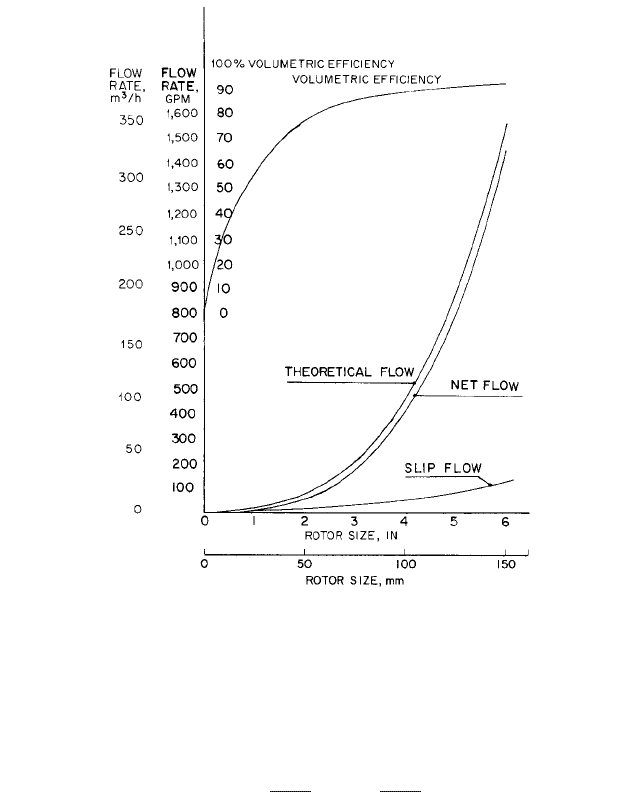
3.116 CHAPTER THREE
FIGURE 18 Flow rate and volumetric efficiency as functions of pump size.
Note that this work is done on all the fluid of the theoretical capacity, not just the deliv-
ered capacity, as the slip does not exist until a pressure differential DP occurs. Screw pump
power ratings are expressed in terms of horsepower (550 ft-lbf/sec) in USCS units and in
terms of kilowatts in SI units. The theoretical liquid horsepower (kilowatts) can be calcu-
lated as follows:
It should be noted that the theoretical liquid horsepower (kilowatts) is independent of
the viscosity and is a function only of the physical dimensions of the pumping elements,
the rotative speed, and the differential pressure.
The internal power losses are of two types: mechanical and viscous. The mechanical
losses include all the power necessary to overcome the frictional drag of all the moving
parts in the pump, including rotors, bearings, gears, and mechanical seals. The viscous
losses include all the power lost from the fluid drag effects against all the parts in the
pump as well as from the shearing action of the fluid itself. It is probable that the mechan-
ical loss is dominant when operating at low viscosities and high speeds, and the viscous
loss is the larger of these two losses at high-viscosity and slow-speed conditions.
In general, the losses for a given type and size of pump vary with the viscosity and the
rotative speed and may or may not be affected by pressure, depending upon the type and
twhp
Q
t
¢P
1714
atkW
Q
t
¢P
36
b
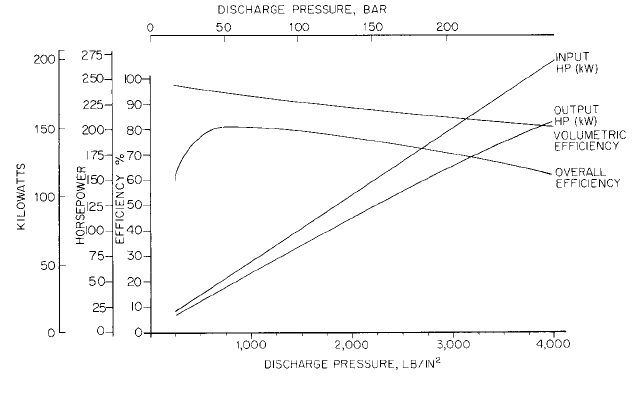
3.7 SCREW PUMPS 3.117
FIGURE 19 Typical overall efficiency curves.
model of pump under consideration. These losses, however, must always be based upon the
maximum viscosity to be handled since they will be highest at this point.
The actual pump power output, whp (wkW), or the delivered liquid horsepower (kilo-
watts), is the power imparted to the liquid by the pump at the outlet. It is computed sim-
ilarly to theoretical liquid horsepower (kilowatts) using Q in place of Q
t
. Hence, the value
will always be less. The pump efficiency E
p
is the ratio of the pump power output to the
brake horsepower (see Figure 19).
SPECIAL MULTIPHASE APPLICATIONS __________________________________
Screw pumps have been used with gas-entrained applications for many years, but recent
process changes in oil field technologies have created requirements for pumping multi-
phase fluids, containing more than just nominal amounts of gases. In many oil well appli-
cations, the liquid oil flow eventually degenerates into all sorts of difficult multiphase
mixtures of oil, gas, water, and sand. In the past, it was common for the gas to be separated
and flared off at the well head with only the liquid product to be retained for further pro-
cessing. If the gas is to be processed as well, separators, compressors, and dual pipelines
are required to handle the gas phase. Therefore, a pump, which can handle these difficult
liquids with high gas content, can save significant equipment costs as well as operating
costs. Under various conditions, the well output can vary from 100 percent liquid to 100
percent gas and all possible combinations. The applications also require the pumping
equipment to be able to switch rapidly between the extremes or to handle slugs of liquid
or gas, while maintaining the full discharge pressure. The timed two-screw type of pump
has proven capable of pumping these multiphase products.
1
Oil well applications can include traditional on-shore sites as well as off-shore platform
installations. Subsea installations are also being used to reduce the high costs of equip-
ment and operation of traditional oil platforms. In these applications, the pumping equip-
ment is mounted on the sea bed with piping running to on-shore gathering facilities.
Although the actual pumping conditions are similar to surface installations, the installa-
tion and operating environments are far more challenging.
When pumping multiphase products with high gas void fractions (GVF), the pump
must be designed with a small pitch to provide a sufficient number of locks. The key to
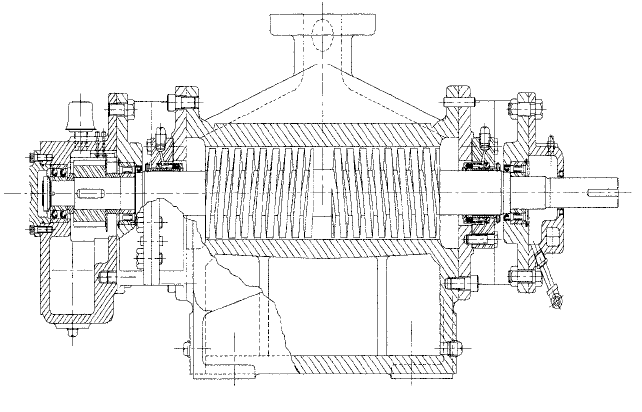
3.118 CHAPTER THREE
FIGURE 20 Special screw pump for multiphase applications. (Flowserve Corporation)
pumping multiphase products is to ensure that some liquid is always available to seal the
screw clearances and reduce the slip. Even a small amount of recirculated liquid is suffi-
cient to provide this seal and enable the screw pump to operate with GVFs approaching
100 percent. Depending on a number of factors, the volume of liquid required to seal and
cool the screws can be three to six percent of the total inlet volume flow rate. In order to
ensure that sufficient liquid is available at conditions of high GVFs, a separate liquid flush
can be provided or a separator type of pump body can be used. This type of body includes
a special chamber that can separate some liquid from the multiphase mixture being
pumped. This liquid can be recirculated back to the screws and mechanical seals to pro-
vide sealing and cooling liquid at times when the product is almost all gas. Figure 20
shows a special screw pump designed for multiphase applications with a separating cham-
ber built into the body.
2
When pumping liquids, the slip through the internal clearances is proportional to the dif-
ferential pressure and inversely proportional to the viscosity. However, in multiphase appli-
cations, as the GVF increases, the slip decreases until the inlet volume flow rate is equal to
the pump displacement.This results in an almost constant inlet volume flow rate, regardless
of the differential pressure. This performance can be explained by examining the pressure
drop of the multiphase product across the finite clearances. This theoretical analysis con-
firms that a small amount of liquid in the clearances will effectively seal these clearances
and reduce the slip to near zero. Figure 21 shows the typical performance characteristics for
a screw pump in a multiphase application when pumping mixtures of air and water at var-
ious GVF values.
3
It should be emphasized that screw pumps must be sized for the inlet volume con-
ditions. Since the gas portion of the multiphase product is compressible, the inlet pres-
sure and temperature conditions must be known in order to calculate the gas volume.
The pump will ingest a fixed volume of product and the amount of liquid being pumped
will depend on how much of this volume is being displaced by gas at the inlet to the
screws.
The newest area of application for multiphase pumps is subsea. With special modifica-
tions,the rotary screw multiphase pumps can be coupled to submersible motors and mounted
on the sea bed, instead of on surface platforms. The idea of pumping multiphase products
directly from a subsea well head to shore facilities by means of submersible multiphase
pumps has significant potential savings in separating equipment and platforms.
4
Figure 22

3.7 SCREW PUMPS 3.119
FIGURE 22 Multiphase screw pump for subsea application.
FIGURE 21 Typical performance of a screw pump on multiphase products (bar = psi/14.504).
shows a special, timed, two-screw pump, configured for subsea multiphase applications, with
special, product-lubricated outboard bearings and pressure-compensated, lube oil chambers.
INSTALLATION AND OPERATION _______________________________________
Rotary pump performance and life can be improved by following the recommendations on
installation and operation outlined in this section.
Pipe Size Resistance to the flow usually consists of differences in elevation, fixed resis-
tances or restrictions such as orifices, and pipe friction. Nothing can be done about the
first, since this is the basic reason for using a pump. Something can be done, however,
about restrictions and pipe friction. Significant amounts of money can be wasted because
of piping that is too small for the job. Certainly, not all pipe friction can be eliminated as
long as fluids must be handled in this manner, but every effort should be made to use the
largest pipe that is economically feasible. Numerous tables are available for calculating
frictional losses in any combination of piping.Among the most recent are the tables in the
3.120 CHAPTER THREE
Hydraulic Institute Engineering Data Book (Reference 5) along with other similar hydraulic
engineering references.
Before any new installation is made, the cost of larger-size piping, which will result in
lower pump pressures, should be carefully balanced against the cost of a less expensive
pump, a smaller motor, and a savings in power over the expected life of the system. The
larger piping may cost a little more in the beginning, but the ultimate savings in power
will often substantially offset the original cost. These facts are particularly true for
extremely viscous fluids.
Foundation and Alignment The pump should be mounted on a smooth, solid founda-
tion readily accessible for inspection and repair. It is essential that the driver shaft and
the pump shaft are in proper alignment. The manufacturer’s recommendation of concen-
tricity and parallelism should always be followed and checked occasionally.
The suction pipe should be as short and straight as possible with all joints airtight. It
should not contain places where air or other entrapped gases may collect. If it is not pos-
sible to have the fluid flow to the pump under gravity, a foot or check valve should be
installed at the end of the suction line or as far from the pump as possible. All piping
should be independently supported to avoid strains on the pump casing.
Start-Up A priming connection should be provided on the suction side, and a relief valve
should be set from five to ten percent above the maximum working pressure on the dis-
charge side. Under normal operating conditions with completely tight inlet lines and wet-
ted pumping elements, a screw pump is self-priming. Starting the unit may involve simply
opening the pump suction and discharge valves and starting the motor. It is always advis-
able to prime the unit before the initial startup to wet the screws. In new installations,
the system may be full of air, which must be removed. If this air is not removed, the per-
formance of the unit will be erratic, and, in certain cases, air in the system can prevent
the unit from pumping. Priming the pump should preferably consist of filling not only the
pump with fluid but as much of the suction line as possible.
The discharge side of the pump should be vented at startup. Venting is especially
essential when the suction line is long or when the pump is initially discharging against
the system pressure.
If the pump does not show a discharge of liquid after being started, the unit should
be shut down immediately. The pump should then be primed and tried again. If it still
does not pick up fluid promptly, there may be a leak in the suction pipe, or the trouble
may be traceable to an excessive suction lift from an obstruction, throttled valve, or
another cause. Attaching a gage to the suction pipe at the pump will help locate the
trouble.
Once the screw pump is in service, it should continue to operate satisfactorily with
practically no attention other than an occasional inspection of the mechanical seal or pack-
ing for excessive leakage and a periodic check to be certain that the alignment is main-
tained within reasonable limits.
Noisy Operation Should the pump develop noise after satisfactory operation, this is
usually indicative of an excessive suction lift resulting from cold liquid, air in the liquid,
misalignment of the coupling, or, in the case of an old pump, excessive wear.
Shutdown Whenever the unit is shut down, if the operation of the system permits, both
the suction and discharge valves should be closed. This is particularly important if the
shutdown is for an extended period because leakage in the foot valve, if the main supply
is below the pump elevation, could drain the oil from the unit and necessitate repriming
as in the initial starting of the system.
Abrasives One other point has not yet been discussed, and this is the handling of liq-
uids containing abrasives. Since screw pumps depend upon close clearances for proper
pumping action, the handling of abrasive fluids usually causes rapid wear. Much progress
has been made in the use of harder and more abrasive-resistant materials for the pump-
ing elements so that a good job can be done in some instances. It cannot be said, however,
3.7 SCREW PUMPS 3.121
that performance is always satisfactory when handling liquids laden excessively with
abrasive materials. On the whole, screw pumps should not be used for handling fluids of
this character unless a shortened pump life and an increased frequency of replacements
are acceptable. In these cases, reducing the operating speed can maximize the operating
life of the pump.
CONCLUDING REMARKS______________________________________________
As indicated, screw pumps are manufactured in a number of different configurations and
designs to suit a variety of different applications. Generally, screw pumps should be con-
sidered if there is a requirement for high pressure, high viscosity, or low hydraulic pulsa-
tion levels. Screw pumps can be used with lubricating and non-lubricating products and
on many special and difficult applications. The keys to the success of screw pump appli-
cations include accurate knowledge of the fluid characteristics, proper pump selection and
sizing, correct system design, suitable installation conditions, and the proper operating
and maintenance procedures.
REFERENCES _______________________________________________________
1. Vetter, G., and others. Tutorial: “Multiphase Pumping with Twin-Screw Pumps—
Understand and Model Hydrodynamics and Hydroabrasive Wear.” Proceedings of the
17th International Pump Users Symposium, Texas A&M University, College Station
TX, March 2000, pp. 153–169.
2. Prang, A. “Selecting Multiphase Pumps.” Chemical Engineering, February 1997,
pp. 74
—
79.
3. Vetter, G., and Wincek, M. “Peformance Prediction of Twin Screw Pumps for Two-Phase
Gas/Liquid Flow.”Pumping Machinery
—
1993, FED-Vol. 154,ASME, 1993, pp. 331–340.
4. Cooper, P., Prang, A. J., and Thamsen, P. U. “Applying Multiphase Pumps Subsea.”Pro-
ceedings of the Seventh European Congress on Fluid Machinery, Institution of
Mechanical Engineers, London, Paper No. C556/006/99, April 1999.
5. Hydraulic Institute Engineering Data Book, 2nd Edition, 1990, Hydraulic Institute,
Parsippany, NJ www.pumps.org.

ROBERT A. PLATT
C. W. LITTLE, JR.
3.123
SECTION 3.8
VANE, GEAR,
AND LOBE PUMPS
DEFINITIONS AND NOMENCLATURE ____________________________________
Vane, gear, and lobe pumps are positive displacement rotary pumps. The Hydraulic Insti-
tute defines them as mechanisms consisting of a casing with closely fitted vanes, gears,
cams, or lobes that provide a means for conveying a fluid. Their principle motion is rotat-
ing, rather than reciprocating, and they displace a finite volume of fluid with each shaft
revolution. When describing them, the general term fluid is used, rather than the more
restrictive liquid. Fluid, in this case, is understood to include not only true liquids, but
mixtures of liquids, gases, vapors, slurries, and solids in suspension as well.
How They Work Pumping in a vane, gear, or lobe pump begins with the rotating and
stationary parts of the pump defining a given volume or cavity of fluid enclosure. This
enclosure is initially open to the pump inlet but sealed from the pump outlet and expands
as the pump rotates. As rotation continues, the volume progresses through the pump to
a point where it is no longer open to the pump inlet but not yet open to the pump outlet.
It is in this intermediate stage where the pumping volume or cavity is completely formed.
Depending on the particular pump, there can be more than one cavity in existence at any
one time.As this happens, fluid also fills the clearances between the pumping elements and
pump body, forming a seal and lubricating the pumping elements as they in turn pump the
fluid. Rotation continues and the cavities progress, moving fluid along the way. Soon a point
is reached where the seal between the captured fluid volume and outlet part of the pump is
breached.At this point the vanes, gears, or lobes force the volume of captured fluid out of the
pump. While this is happening, other cavities are simultaneously opening at the inlet port
to receive more fluid in a continual progression from suction to discharge ports.
For optimum pumping action, the open-to-inlet (OTI) volume should expand slowly and
continuously with pump rotation. The closed-to-inlet-and-outlet (CTIO) pumping cavity
volume should remain constant once it is formed, and the open-to-outlet (OTO) volume
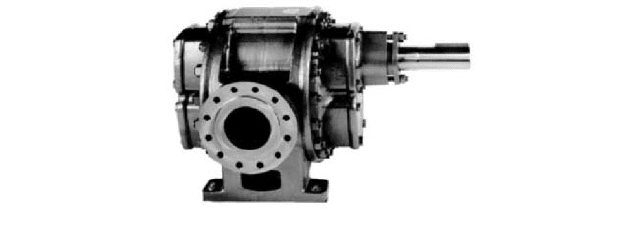
3.124 CHAPTER THREE
FIGURE 1 A typical rotary gear pump
should expand slowly and continuously with pump rotation. At no time should any fluid
in the pumping chambers be simultaneously open to both the inlet and outlet if the pump
is truly a positive displacement pump. When these conditions are met, the result is a very
smooth continuum of flow with minimal pulsations or pressure spikes.
With rotary pumps (see Figure 1), a driver turns one shaft and rotor assembly, which
in turn physically meshes with another to form the cavities that move the fluid. This is
known as an untimed arrangement. For some applications, however, there would be prob-
lems with the gears, lobes, or screws meshing this way. For instance, stainless steel gears
will gall and seize if rubbed against each other. High wear rates will also occur if any dirt
is trapped between the meshing lobes of a lobe pump, regardless of their material, or if a
pump with meshing gears is run dry.
To circumvent this, the timed pump was developed. It uses timing gears physically
located outside the pumping chamber to transmit torque between the pump shafts and
synchronize the pumping elements relative to each other. By preventing them from con-
tacting each other, they eliminate many of the problems of dirty fluids, material compati-
bility, and dry running. Most lobe pumps are built this way, and gear pumps can be timed
or untimed as well.
In some special cases, pressure-balancing designs, relief valve arrangements, or other
such considerations have led to some designs where the pump can only operate in one
direction. However, the principle of operation of most rotary pumps permits them to oper-
ate equally well in either direction.
Main Components The pumping chamber of a rotary pump is the area containing the
pumped fluid while the pump is operating. Fluid enters the pumping chamber through
one or more inlet ports and leaves through one or more outlet ports. The body is that part
of the pump that surrounds the boundaries of the pumping chamber and is also referred
to as a casing, housing, or stator. End plates can either be part of the body or separate
parts, and they serve to close off the ends of the body to form the pumping chamber. End
plates can also be referred to as pump covers.
The rotating assembly generally refers to all those parts that rotate when the pump is
operating. Rotors are usually given more descriptive names, depending on the specific
pump type.All rotary pumps employ a drive shaft to accept driving torque from the pump
driver. The majority of rotary pumps are mechanically coupled to their driver with various
types of couplings, but sealless magnetically driven pumps have become more common in
recent years.
The cavity through which the drive shaft protrudes is called the seal chamber, and leak-
age through it is controlled by a mechanical seal or packing. In a mechanical seal, two faces
with opposing axial loads are maintained in close contact with each other. When compress-
ible packing and a stuffing box are used in place of a mechanical seal and seal chamber, the
packing is compressed in the stuffing box by a gland that keeps it in intimate contact with
the stationary and rotating elements.A lantern ring or seal cage is often placed between two
of the packing rings to enable cooling and lubrication from an external source.
